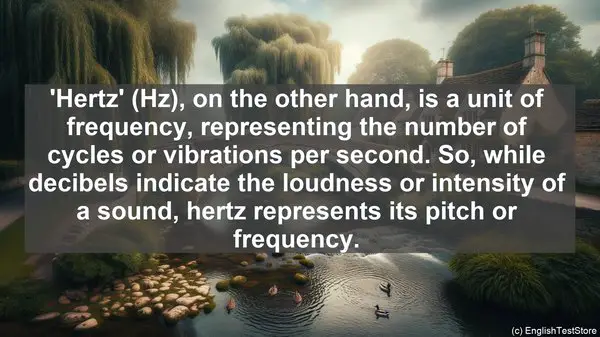Introduction
Welcome to today’s lesson on bioacoustics research. In this lesson, we’ll be focusing on some commonly confused words that often arise in this field. Understanding these terms correctly is crucial for accurate communication and interpretation of research findings. So, let’s dive in!
1. Acoustic vs. Auditory
The first pair of words that often cause confusion is ‘acoustic’ and ‘auditory.’ While both relate to sound, ‘acoustic’ refers to the physical properties of sound, such as frequency and amplitude. On the other hand, ‘auditory’ pertains to the perception and processing of sound by living organisms. So, when discussing the characteristics of a sound signal, we use ‘acoustic,’ and when referring to how an organism hears or responds to that sound, we use ‘auditory.’
2. Spectrogram vs. Sonogram
Next up, we have ‘spectrogram’ and ‘sonogram.’ These terms are often used interchangeably, but they have distinct meanings. A ‘spectrogram’ is a visual representation of sound that displays the frequency, intensity, and time information. On the other hand, a ‘sonogram’ is a specific type of spectrogram that focuses on the frequency content of a sound over time. So, while all sonograms are spectrograms, not all spectrograms are sonograms.
3. Bioacoustics vs. Psychoacoustics
Moving on, let’s clarify the difference between ‘bioacoustics’ and ‘psychoacoustics.’ ‘Bioacoustics’ is the study of sound in living organisms, including their production, reception, and behavior. It often involves fieldwork and focuses on the ecological and biological aspects of sound. On the other hand, ‘psychoacoustics’ is the study of how humans perceive and interpret sound. It delves into the psychological and cognitive aspects of auditory perception.

4. Call vs. Song
The terms ‘call’ and ‘song’ are frequently used when discussing animal vocalizations. ‘Call’ generally refers to a short, simple vocalization used for communication, such as a contact call. On the other hand, a ‘song’ is a more complex and often longer vocalization, typically associated with territorial or mating displays. While the distinction between the two can sometimes be blurry, it’s important to differentiate them based on their characteristics and context.
5. Echolocation vs. Sonar
Next, let’s clarify the difference between ‘echolocation’ and ‘sonar.’ Both involve the use of sound for navigation or detecting objects, but they are used by different organisms. ‘Echolocation’ is a term used for the biological sonar system used by animals like bats and dolphins. They emit sound signals and interpret the echoes to perceive their surroundings. ‘Sonar,’ on the other hand, is a technology used by humans, where sound waves are emitted and the echoes are analyzed to determine the presence or location of objects underwater.

6. Ambient Noise vs. Background Noise
When discussing sound environments, the terms ‘ambient noise’ and ‘background noise’ often come up. ‘Ambient noise’ refers to the overall sound present in a particular environment, which can include both natural and human-generated sounds. ‘Background noise,’ on the other hand, specifically refers to the unwanted or interfering sounds that can affect the clarity or perception of a desired sound. So, while all background noise is ambient noise, not all ambient noise is necessarily background noise.
7. Passive Acoustic Monitoring vs. Active Acoustic Monitoring
In the realm of acoustic monitoring, we have ‘passive acoustic monitoring’ and ‘active acoustic monitoring.’ ‘Passive acoustic monitoring’ involves the use of specialized recorders or hydrophones to capture and analyze sounds in an environment continuously. It’s often used for long-term monitoring or studying natural soundscapes. ‘Active acoustic monitoring,’ on the other hand, refers to the deliberate emission of sound signals, typically for the purpose of detecting or tracking specific targets, such as marine mammals or fish.
8. Decibel vs. Hertz
Two fundamental units of sound measurement are ‘decibel’ and ‘hertz.’ ‘Decibel’ (dB) is a logarithmic unit used to express the intensity or level of a sound. It’s a relative scale, often referenced to a standard threshold, such as the hearing threshold of humans. ‘Hertz’ (Hz), on the other hand, is a unit of frequency, representing the number of cycles or vibrations per second. So, while decibels indicate the loudness or intensity of a sound, hertz represents its pitch or frequency.
9. Infrasound vs. Ultrasound
When discussing sound frequencies, ‘infrasound’ and ‘ultrasound’ are often mentioned. ‘Infrasound’ refers to sound waves with frequencies below the lower limit of human hearing, typically below 20 Hz. It’s often produced by natural phenomena like earthquakes or large-scale events. ‘Ultrasound,’ on the other hand, refers to sound waves with frequencies above the upper limit of human hearing, typically above 20,000 Hz. It’s commonly used in medical imaging or animal communication, where the higher frequencies offer advantages.
10. Acoustic Ecology vs. Soundscape Ecology
Lastly, let’s differentiate between ‘acoustic ecology’ and ‘soundscape ecology.’ ‘Acoustic ecology’ is the study of the relationship between living organisms and their acoustic environment, focusing on the interactions, adaptations, and impacts of sound. ‘Soundscape ecology,’ on the other hand, takes a broader approach, considering the entire acoustic environment, including both natural and human-generated sounds, and their ecological significance. It often involves analyzing and characterizing soundscapes in different habitats or ecosystems.

